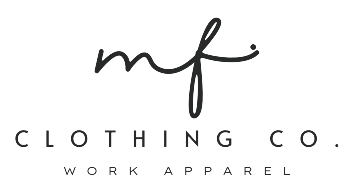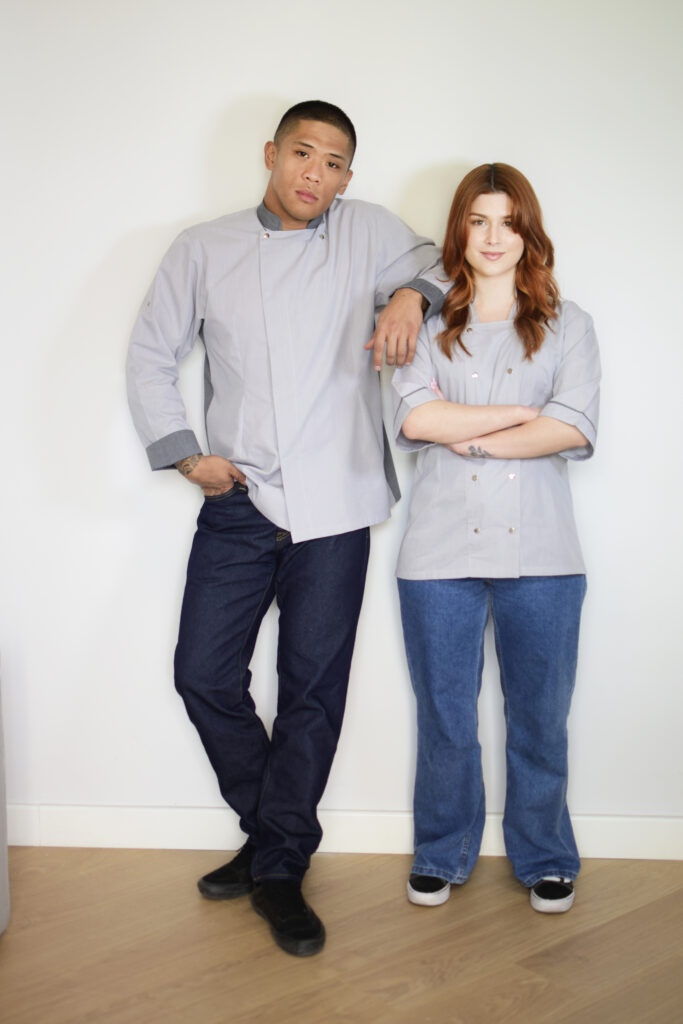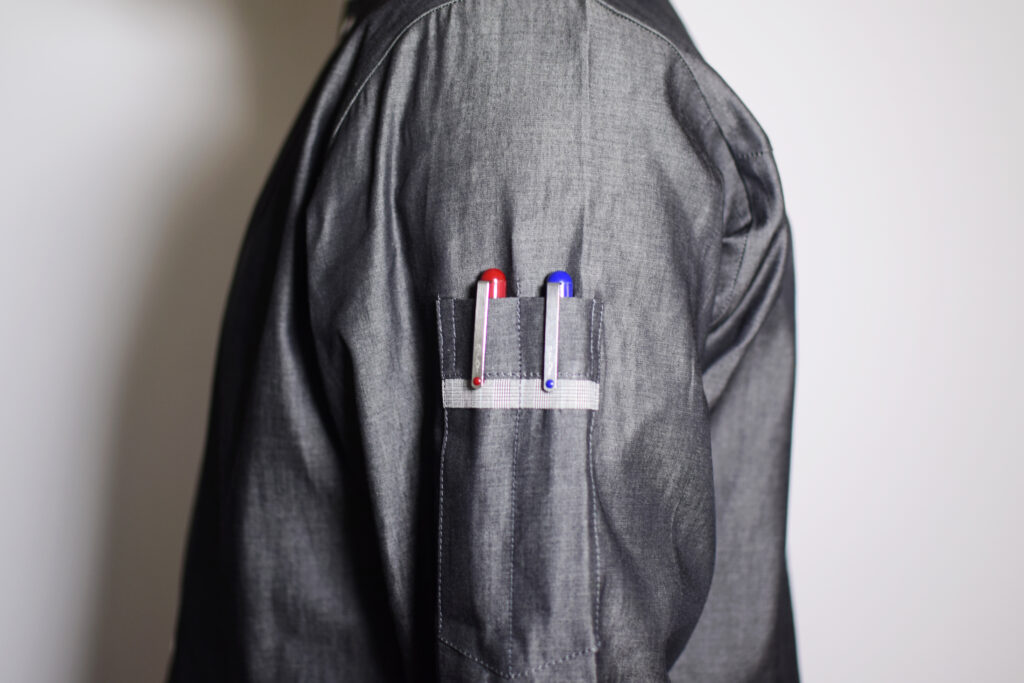Chef uniforms play an essential role in hospitality industry and this is not only because this helps the culinary professionals have and maintain a polished and professional appearance but also because they promote hygiene and safety in the kitchen. Chef uniforms typically include durable, heat-resistant jackets, pants and aprons that are designed for comfort and functionality. Similarly, hospitality uniforms, such as front desk uniforms, serve to create a welcoming atmosphere for guests, with designs that create a sense of formality and professionalism. Just as important are the uniforms for bartenders, which are designed for mobility and style, respecting the mobility of their profession while at the same time maintaining a sophisticated look that complements the overall aesthetic of the bar or restaurant. All together, these professional uniforms contribute to the professional image and smooth operation of any hospitality business.
What is a Chef Uniform and Why is it Important
A chef uniform is an outfit designed for culinary professionals to make sure that they remain safe in the kitchen yet in a professional attire. Usually, it consists of chef jackets, pants, apron and sometimes a hat. This uniform should be made from durable, heat resistant materials to protect chefs from hot surfaces, spills or burns. Beyond the practicality of this uniform, it is also designed to maintain a clean, hygienic work environment, which is vital in food preparation. For all businesses, a well-designed chef uniform is important not only for safety anf comfort but also for presenting a professional image to customers. A variety of options to suit your needs can be found in a hospitality uniform catalogue, which offers a range of designs that blend functionality with brand identity. Investing in high-quality uniforms ensures that staff are equipped to perform at their best while reinforcing your brand’s commitment to excellence and cleanliness.
Essential Components of a Chef Uniform
Chef Coat: Double-Breasted and Long Sleeves
Double breasted and long-sleeve chef coats are an epitome of professionalism in many kitchens, offering both practicality and style. The double breasted design allows chefs to reserve the coat fast if it becomes stained, while the long sleeves provide extra protection from heat, splatters and sharp kitchen tools.
Chef Hat (Toque): Tradition and Practicality
Chef hats, or toques, are a traditional symbol of culinary expertise, with their height often indicating the chef’s rank in the kitchen hierarchy. Beyond tradition, these hats serve a practical purpose by keeping hair neatly contained and preventing it from falling into food, while also providing a layer of protection against heat and splattering oils during cooking.
Apron: Essential for a Chef’s Protection
Aprons are an essential part of a chef’s uniform, providing crucial protection against heat, splatters, and spills in the kitchen. Made from durable, heat-resistant materials, aprons help ensure that chefs stay safe while working near hot surfaces and maintain a clean appearance throughout their shift.
Chef Pants: Durable and Comfortable
Chef pants are designed for durability and comfort, allowing culinary professionals to move freely and work long hours in the kitchen. Made from breathable, flexible fabrics, these pants are built to withstand the demands of a fast-paced environment while keeping chefs comfortable and focused on their tasks.
Footwear for Chefs: Slip-Resistant and Comfortable
Footwear for chefs is specifically designed to be slip-resistant, providing traction on wet or greasy kitchen floors to prevent accidents. In addition to safety, these shoes are crafted for comfort, offering support during long hours of standing and moving, helping chefs maintain focus and productivity throughout their shifts.

Different Styles and Colors of Chef Uniforms
Traditional White Chef Uniforms
Traditional white chef uniforms, often consisting of a double-breasted jacket, checkered pants, and a tall toque (hat), are designed for both practicality and professionalism. The white color symbolizes cleanliness and hygiene, while the layered jacket helps protect chefs from heat and spills in the kitchen. These uniforms also serve to distinguish chefs as skilled professionals, reflecting a long-standing culinary tradition.
Modern Variations: Black, Blue, and Patterned Chef Coats
Modern variations of chef uniforms have expanded beyond the classic white, with black, blue, jeans and patterned chef coats becoming increasingly popular in culinary uniforms collections. These kind of designs offer a more personalized and stylish approach, while still maintaining the functionality and comfort needed in this kind of professions. Black and blue coats often provide a sleek, professional look, while patterned or jeans styles allow chefs to express creativity, all while upholding the standards of hygiene and practicality.
Personalized and Branded Chef Uniforms
Personalized and branded chef uniforms are becoming a key element in creating a unique identity for culinary teams, with custom uniform services offering the ability to add logos, names, and other essential details. These customized uniforms not only enhance brand recognition but also create a sense of pride and professionalism among staff. Whether for a restaurant, catering business, or food service operation, personalized chef attire can create a neat appearance while maintaining the necessary functionality for kitchen work.
Choosing the Right Material for Chef Uniforms
Cotton vs. Polyester Chef Uniforms
Cotton chef uniforms are favored for their breathability and comfort, making them ideal for hot kitchen environments, though they may wrinkle easily and require more maintenance. On the other hand, polyester chef uniforms are more durable, resistant to wrinkles, and require less care, but they may not offer the same level of breathability as cotton. Nevertheless polyester made chef uniforms are lately created by breathable or recycled polyester which is a more appropriate material for this kind of use.
Breathable Fabrics for High-Heat Kitchens
Breathable fabrics, such as cotton and moisture-wicking blends, are essential for high-heat kitchens as they help regulate body temperature and keep chefs comfortable during long hours of intense work. These fabrics allow air circulation, reducing sweat and providing ventilation to maintain a cool and dry environment, even in the hottest conditions.
Replacing Old or Damaged Uniforms
Replacing old or damaged chef uniforms is crucial for maintaining a professional appearance and ensuring safety in the kitchen. Worn-out attire can compromise both functionality and hygiene, so regularly updating uniforms helps ensure comfort, protection, and a polished look for the entire culinary team.
How to Select the Best Chef Uniform for Your Needs
MF Clothing Co. is a leading hospitality uniform supplier with a specialized focus on high-quality chef uniforms, offering a wide range of options to suit the unique needs of any kitchen or culinary team. With years of expertise in the industry, we provide custom solutions that cater to both functional and aesthetic requirements, ensuring comfort, durability, and style for chefs of all levels. Whether you’re outfitting a fine-dining restaurant, a catering service, or a fast-paced kitchen, MF Clothing Co. can meet the demands of any brand, delivering tailored uniforms that elevate both the professional image and operational efficiency of your team.
FAQs about Uniforms for Chefs
What is included in a chef’s uniform?
A chef’s uniform typically includes a double-breasted jacket, checkered or solid pants, a toque (hat), apron, and comfortable shoes, all designed for safety, hygiene, and comfort in the kitchen.
Why do chefs wear double-breasted coats?
Chefs wear double-breasted coats for added protection, as the extra layer can be reversed in case of spills, while also providing comfort and a professional appearance in the kitchen.
Is it necessary for a chef to wear a hat?
While not strictly necessary, wearing a hat is essential for chefs to maintain hygiene by keeping hair contained and preventing it from falling into food, while also adhering to traditional culinary standards.
Are chef uniforms supposed to be white?
Traditionally, chef uniforms are white to symbolize cleanliness and professionalism, but modern variations in black, blue, and patterned designs have become increasingly popular in recent years.
What material is best for chef uniforms?
The best material for chef uniforms is typically a breathable, durable cotton or a cotton-blend fabric, as it provides comfort, moisture-wicking properties, and ease of movement in the high-heat environment of a kitchen.
How should I care for my chef uniform?
To care for your chef uniform, wash it regularly in warm water with mild detergent, avoid harsh chemicals, and ensure it’s properly dried to maintain its shape and fabric integrity, while also ironing or steaming as needed to remove wrinkles.
Interested in a Wholesale Order?
For bulk purchases and special pricing, contact us today! Fill out the form below, and our team will get back to you shortly.












